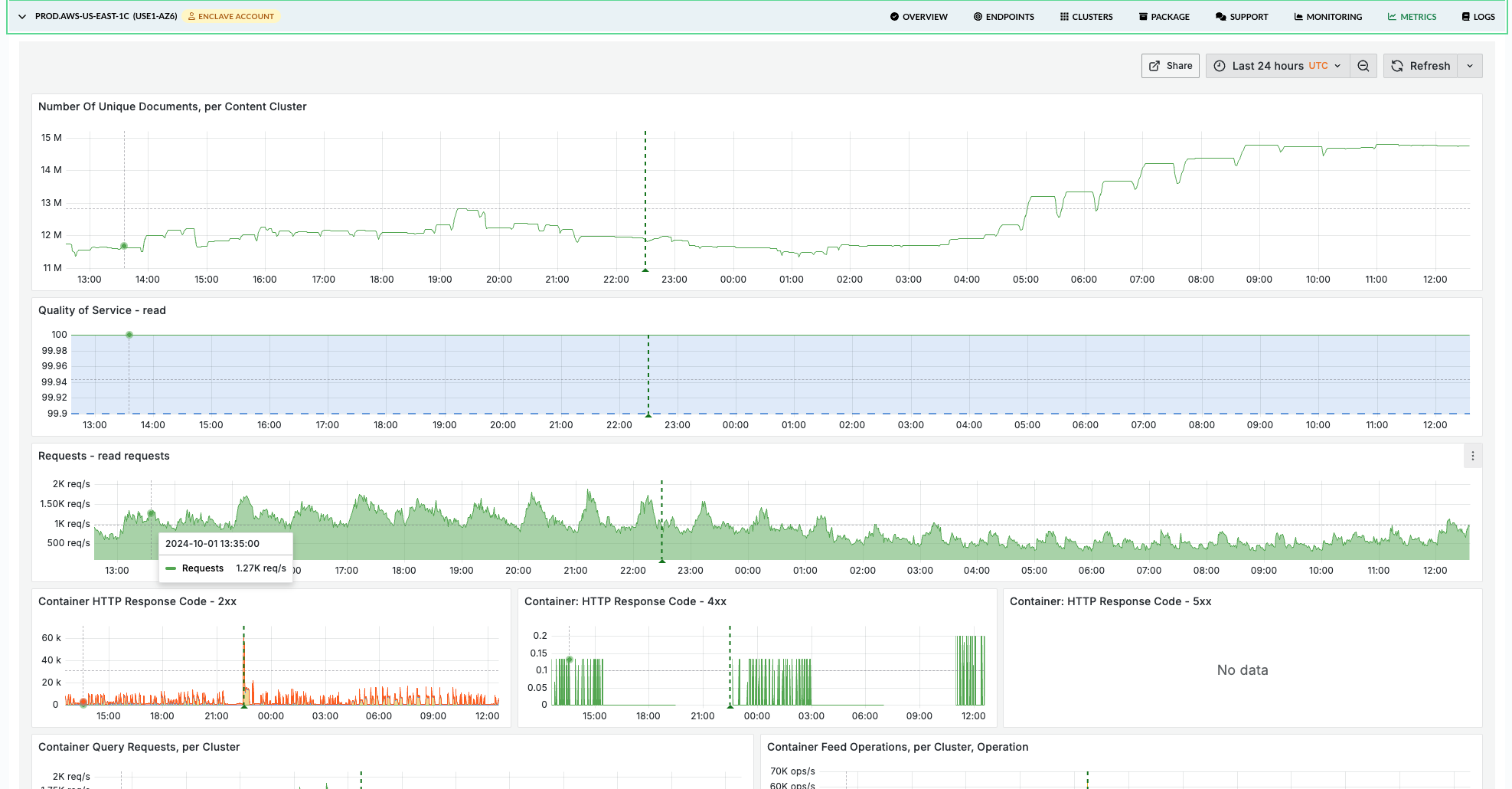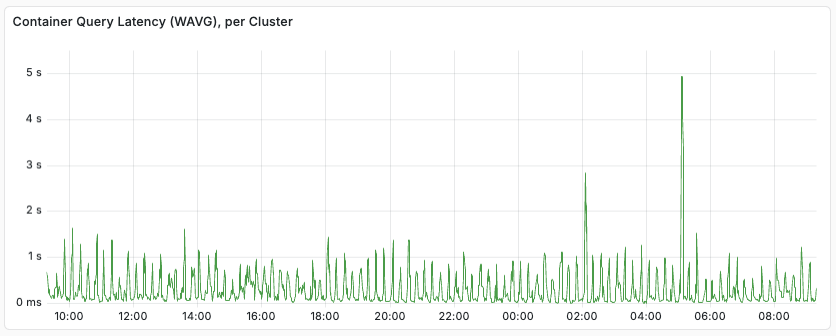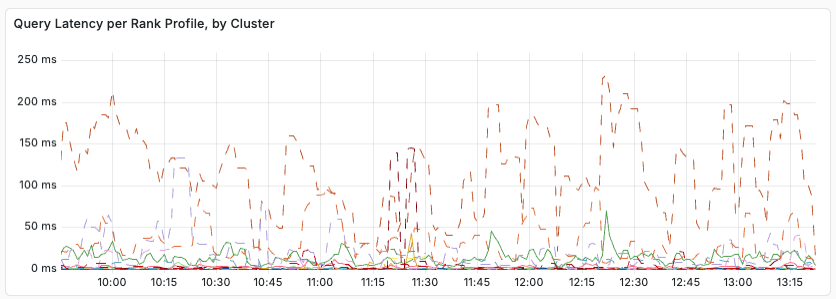
The Vespa Cloud Console has dashboards for insight into performance metrics, use the METRICS tab in the application zone view.
These metrics can also be pulled into external monitoring tools using the Prometheus metrics API.
Latency tracking
When monitoring latency in clusters with mixed loads, it is useful to use rank profiles to separate them. As an example, an application might have user queries mixed with agentic, batch-oriented queries. Tracking the Container-level query latencies might look like:

Using Content node level metrics, separated by ranking profile, we see:

From this, we see that query latency varies with the rank profile used. Relevant metrics to export to your monitoring system include:
- content.proton.documentdb.matching.rank_profile.queries
- content.proton.documentdb.matching.rank_profile.docs_matched
- content.proton.documentdb.matching.rank_profile.query_latency
- content.proton.documentdb.matching.rank_profile.rerank_time
In short, when debugging latency, look for changes, per rank profile:
- Did the query rate increase?
- Did number of matched or ranked documents change?
The above metrics is a subset or the available metrics. It is a good idea to set a query profile per class of query, and in each query profile, select a distinct rank profile. With this, you can change the rank profile for a given query class by configuration only (no need to change the clients) - a good example is having a lightweight rank profile to use in overload situations. This makes it easier to track the individual query classes, per rank profile.
Prometheus metrics API
Prometheus metrics are found at $ENDPOINT/prometheus/v1/values:
$ curl -s --cert data-plane-public-cert.pem --key data-plane-private-key.pem \ 'https://b6718765.b68a1234.z.vespa-app.cloud/prometheus/v1/values'
The metrics can be fed into e.g. your Grafana Cloud or self-hosted Grafana instance. See the Vespa metrics documentation for more information.
Using Grafana
This section explains how to set up Grafana to consume Vespa metrics using the Prometheus API.
1. Prometheus configuration
Prometheus is configured using prometheus.yml, find sample config in
prometheus.
See prometheus-cloud.yml,
which is designed to be easy to set up with any Vespa Cloud instance.
Replace <Endpoint> and <SERVICE_NAME> with the endpoint
for the application and the service name, respectively.
In addition, the path to the private key and public cert
that is used for the data plane to the endpoint need to be provided -
refer to security.
Then, configure the Prometheus instance to use this configuration file.
The Prometheus instance will now start retrieving the metrics from Vespa Cloud.
If the Prometheus instance is used for multiple services,
append the target configuration for Vespa to scrape_configs.
2. Grafana configuration
Use the provisioning folder as a baseline for further configuration.
In the provisioning folder there are a few different files that all help for configuring Grafana locally.
These work as good examples of default configurations,
but the most important is the file named Vespa-Engine-Advanced-Metrics-External.json.
This is a default dashboard, based upon the metrics the Vespa team use to monitor performance.
Click the + button on the side and go to import. Upload the file to the Grafana instance. This should automatically load in the dashboard for usage. For now, it will not display any data as no data sources are configured yet.
3. Grafana Data Source
The Prometheus data source has to be added to the Grafana instance for the visualisation. Click the cog on the left and then "Data Sources". Click "Add data source" and choose Prometheus from the list. Add the URL for the Prometheus instance with appropriate bindings for connecting. The configuration for the bindings will depend on how the Prometheus instance is hosted. Once the configuration details have been entered, click Save & Test at the bottom and ensure that Grafana says "Data source is working".
To verify the data flow, navigate back to the Vespa Metrics dashboard by clicking the dashboard symbol on the left (4 blocks) and clicking manage and then click Vespa Metrics. Data should now appear in the Grafana dashboard. If no data shows up, edit one of the data sets and ensure that it has the right data source selected. The name of the data source the dashboard is expecting might be different from what your data source is named. If there is still no data appearing, it either means that the Vespa instance is not being used or that some part of the configuration is wrong.
Using AWS Cloudwatch
To pull metrics from your Vespa application into AWS Cloudwatch, refer to the metrics-emitter documentation for how to set up an AWS Lambda.
Alerting
The Vespa Grafana Terraform template provides a set of dashboards and alerts. If you are using a different monitoring service and want to set up an equivalent alert set, you can follow this table:
| Metric name | Threshold | Dimension aggregation |
|---|---|---|
| content_proton_resource_usage_disk_average | > 0.9 | max by(applicationId, clusterId, zone) |
| content_proton_resource_usage_memory_average | > 0.8 | max by(applicationId, zone, clusterId) |
| cpu_util | > 90 | max by(applicationId, zone, clusterId) |
| content_proton_resource_usage_feeding_blocked_last | >= 1 | N/A |
All metrics are from the default metric set. Metrics are using the naming scheme from the Prometheus metrics API. Dimension aggregation is optional, but reduces alerting noise - e.g. in the case where an entire cluster goes bad. It is recommended to filter all alerts on zones in the prod environment.
Prometheus Metrics Sample
Below is a sample request with sample response for prometheus metrics for a minimal application on Vespa Cloud:
$ curl -s --cert data-plane-public-cert.pem --key data-plane-private-key.pem \
'https://b6718765.b68a1234.z.vespa-app.cloud/prometheus/v1/values'
...
jdisc_thread_pool_work_queue_size_min{threadpool="default-pool",zone="dev.aws-us-east-1c",applicationId="mytenant.myapp.default",serviceId="logserver-container",clusterId="admin/logserver",hostname="h97490a.dev.us-east-1c.aws.vespa-cloud.net",vespa_service="vespa_logserver_container",} 0.0 1733139324000
jdisc_thread_pool_work_queue_size_min{threadpool="default-handler-common",zone="dev.aws-us-east-1c",applicationId="mytenant.myapp.default",serviceId="logserver-container",clusterId="admin/logserver",hostname="h97490a.dev.us-east-1c.aws.vespa-cloud.net",vespa_service="vespa_logserver_container",} 0.0 1733139324000
# HELP content_proton_documentdb_matching_rank_profile_rerank_time_average
# TYPE content_proton_documentdb_matching_rank_profile_rerank_time_average untyped
content_proton_documentdb_matching_rank_profile_rerank_time_average{rankProfile="rank_albums",documenttype="music",zone="dev.aws-us-east-1c",applicationId="mytenant.myapp.default",serviceId="searchnode",clusterId="content/music",hostname="h104562a.dev.us-east-1c.aws.vespa-cloud.net",vespa_service="vespa_searchnode",} 0.0 1733139324000
content_proton_documentdb_matching_rank_profile_rerank_time_average{rankProfile="unranked",documenttype="music",zone="dev.aws-us-east-1c",applicationId="mytenant.myapp.default",serviceId="searchnode",clusterId="content/music",hostname="h104562a.dev.us-east-1c.aws.vespa-cloud.net",vespa_service="vespa_searchnode",} 0.0 1733139324000
content_proton_documentdb_matching_rank_profile_rerank_time_average{rankProfile="default",documenttype="music",zone="dev.aws-us-east-1c",applicationId="mytenant.myapp.default",serviceId="searchnode",clusterId="content/music",hostname="h104562a.dev.us-east-1c.aws.vespa-cloud.net",vespa_service="vespa_searchnode",} 0.0 1733139324000
...
Relevant labels include:
-
chainThis is the name on the search chain in the container that is used for a set of query requests. This is typically used to get separate metrics, such as latency and the number of queries for each chain over time. -
documenttypeThis is the name of the document type for which a set of queries are run in the content clusters. This is typically used to get separate content layer metrics, such as latency and the number of queries for each chain over time. -
groupIdThis is the id of the cluster group for which the metric measurement is done. This is typically used to get separate metrics aggregates per group in a content cluster. The label is most relevant for metrics from the content clusters running multiple content groups, see Content Cluster Elasticity. The value is in the format group 0, group 1, group 2, etc. -
rankProfileThis label is present for a subset of metrics from the content clusters, with names starting withcontent_proton_documentdb_matching_rank_profile_. The label is typically used in cases where you use multiple rank profiles and want to analyse performance differences between the different rank profiles, or to better understand certain types of performance issues and need to narrow down the candidate set. -
sourceThis is a label applied on container metrics for classifying query failures by the content cluster where the failure was triggered.
How you will use labels to separate different kinds of queries depends on the observability backend you use, but you will typically compute weighted averages for query latency and query volume, and split graphs by the relevant labels to better understand system performance and bottlenecks.
For the container level metrics you use the chain label to differentiate between different query streams,
while you use the rankProfile label to do the same in the content level.